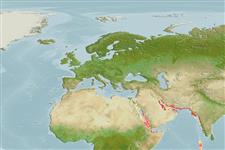Issue
FishBase common name changed from Short-fin goatfish to Shortfin goatfish (Uiblein et al., 2024: Ref. 130857).
Environment: milieu / climate zone / depth range / distribution range
Ecologia
marino associati a barriera corallina; distribuzione batimetrica 0 - 13 m (Ref. 95469). Tropical
Western Indian Ocean: Persian Gulf.
Size / Peso / Age
Maturity: Lm ? range ? - ? cm
Max length : 17.0 cm SL maschio/sesso non determinato; (Ref. 83903)
Short description
Chiavi di identificazione | Morfologia | Morfometria
Spine dorsali (totale) : 8; Raggi dorsali molli (totale) : 9. This species is distinguished by the following characters: D VIII + 9; pectoral fins 13-14; gill rakers 4-7 + 15-18 = 20-24; lateral line scales 29-31; body depth at first dorsal fin origin 22-26% SL and at anus 19-22% SL; caudal-peduncle depth 9.6-11% SL, width 2.2-4.1% SL; maximum head depth 19-23% SL; head depth through eye 15-19% SL; head length 29-33%SL; postorbital length 12-13% SL; orbit length 5.5-8.1% SL; upper jaw length 11-14% SL; barbel length 16-22% SL; caudal-peduncle length 20-25% SL; caudal-fin length 24-28% SL; anal-fin height 15-17% SL; pelvic-fin length 18-22% SL; pectoral-fin length 18-22% SL, width 3.6-5.4% SL; first dorsal-fin height 18-22% SL; second dorsal-fin height 16-18% SL; postorbital length 1.2-1.4 times in anal-fin height; all fins possess dark brown or black stripes, bars or blotches; 6-10 oblique bars on caudal fin in adults (6 or less in juveniles > 7 cm SL), 3-5 brown, dark brown or black bars on upper caudal-fin lobe, 3-4 brown, dark brown or black bars on lower lobe; a dark-brown or black mid-lateral body stripe from tip of snout to caudal-fin base; body and head ground colour white or
beige, slightly darker above lateral line, with irregular dark brown or black spots, dots and blotches; barbels are yellow or pale brown; most of body and fin pigmentation retained on preserved fish (Ref. 95469).
Life cycle and mating behavior
Maturità | Riproduzione | Deposizione | Uova | Fecundity | Larve
Uiblein, F. and P.C. Heemstra, 2010. A taxonomic review of the Western Indian Ocean goatfishes of the genus Upeneus (Family Mullidae), with descriptions of four new species. Smithiana 11:35-71. (Ref. 83903)
IUCN Red List Status (Ref. 130435: Version 2024-1)
Threat to humans
Harmless
Human uses
Strumenti
Special reports
Download XML
Fonti Internet
Estimates based on models
Preferred temperature (Ref.
123201): 24.7 - 28.4, mean 26.8 °C (based on 110 cells).
Phylogenetic diversity index (Ref.
82804): PD
50 = 0.5000 [Uniqueness, from 0.5 = low to 2.0 = high].
Bayesian length-weight: a=0.00933 (0.00439 - 0.01983), b=3.09 (2.92 - 3.26), in cm total length, based on LWR estimates for this Genus-body shape (Ref.
93245).
Trophic level (Ref.
69278): 3.5 ±0.4 se; based on size and trophs of closest relatives
Resilienza (Ref.
120179): Alto, tempo minimo di raddoppiamento della popolazione meno di 15 mesi (Preliminary K or Fecundity.).
Fishing Vulnerability (Ref.
59153): Low vulnerability (11 of 100).
Nutrients (Ref.
124155): Calcium = 88.1 [47.4, 155.1] mg/100g; Iron = 0.642 [0.300, 1.143] mg/100g; Protein = 18 [16, 20] %; Omega3 = 0.154 [0.096, 0.279] g/100g; Selenium = 20.8 [11.6, 38.1] μg/100g; VitaminA = 128 [41, 440] μg/100g; Zinc = 1.45 [0.89, 2.09] mg/100g (wet weight);
